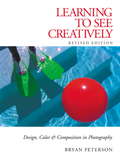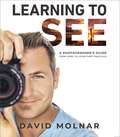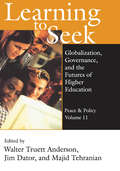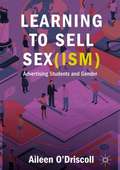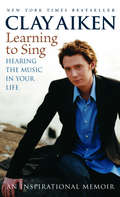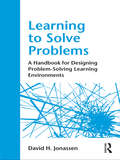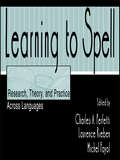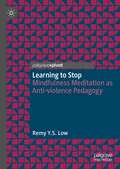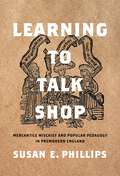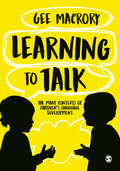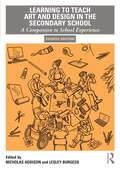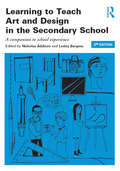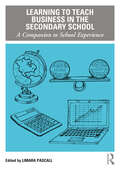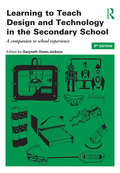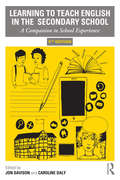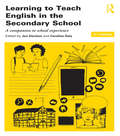- Table View
- List View
Learning to See Creatively: Design, Color and Composition in Photography (Revised Edition)
by Bryan PetersonAlmost everyone can "see" in the conventional sense, but developing photographic vision takes practice. Learning to See Creatively helps photographers visualize their work, and the world, in a whole new light. Now totally rewritten, revised, and expanded, this best-selling guide takes a radical approach to creativity. It explains how it is not some gift only for the "chosen few" but actually a skill that can be learned and applied. Using inventive photos from his own stunning portfolio, author and veteran photographer Bryan Peterson deconstructs creativity for photographers. He details the basic techniques that went into not only taking a particular photo, but also provides insights on how to improve upon it--helping readers avoid the visual pitfalls and technical dead ends that can lead to dull, uninventive photographs. This revised edition features the latest information on digital photography and digital imaging software, as well as an all-new section on color as a design element. Learning to See Creatively is the definitive reference for any photographers looking for a fresh perspective on their work. * Updated to include digital * All new artwork, and a totally revised and expanded text * All-new section on color as a design element.
Learning to See: A Photographer’s Guide from Zero to Your First Paid Gigs
by David MolnarWhether you want to take better photos in your everyday life or make a full-time income as a photographer, the five-part framework author David Molnar teaches in Learning to See will work for you:See: have a vision for your shot and execute that visionShoot: become technically proficient with your cameraEdit: help re-create the emotion from the day of the shootDevelop: identify your area of focus for photographyEarn: start getting paid for your artIt&’s a proven process every photographer follows but few talk about. But if you use it, it will shave years off the learning curve he himself went through as an amateur photographer. This book teaches readers to learn to see, because in the end, that&’s what a photographer does: notice what other people often miss and understand how to capture those things in a masterful way.
Learning to Seek: Globalization, Governance, and the Futures of Higher Education
by Majid Tehranian Jim Dator Walter Truett AndersonThe accelerating technological transformation in learn- ing has necessitated an ability to search and differentiate among the one billion web pages, libraries, databases, books, newspapers, magazines, radio and television stations, and opinion columns available online. This volume focuses on the normative challenges that the current technological transformation presents to all professionals engaged in higher education. Part I concentrates on the current social and technological trends. David Snyder presents an outline of technologies that have made open knowledge systems possible. Majid Tehranian argues that the new technological environment has made learning to seek out information more possible than ever before. Robert Fuller calls for an egalitarian rather than hierarchical approach to communication systems. Harlan Cleveland proposes integrative learning, broad thinking, and globally aware citizenship through "education for wisdom." Part II focuses on problems of governance and finance in the new technological environment. John Hinchcliff takes up the problem of values and argues for the maintenance of traditional altruistic rather than Promethean goals. Karou Yamaguchi comes to the problem of the futures with the tools of system dynamics. William Bergquist calls for a reorganization of higher education to meet the needs for creation, transfer, and inculcation of knowledge and skills. Hamid Shirvani calls for the core values of transparency, integrity, open communication, and dignitarian approach as the guideposts in educational leadership. Walter Truett Anderson concludes by attempting to bring the complex technological, social, economic, and political variables into a holistic approach for the management of higher education. In 2005, at the Universities of the Future Conference, participants were asked to envision the future of higher education. Part III, presents their visions.
Learning to Sell Sex(ism): Advertising Students and Gender
by Aileen O'DriscollThis book presents the first in-depth exploration into the gendered attitudes and worldviews of advertising students. Offering a significant contribution to other cultural sociological works concerning the cultural and creative industries, Learning to Sell Sex(ism) adds further weight to the argument that it is imperative that we look closely at the people who create media texts in order to better account for and challenge sexist media content. In this study, such media creators are the advertising industry’s next generation of practitioners and creatives. Involving a mix of in-depth questionnaires, qualitative surveys, interviews with students, observational data, as well as an examination of the components comprising advertising modules, O’Driscoll documents the dominant gendered discourses articulated by advertising students and offers an opportunity for the advertising educational sector to reflect on how it might play its part in reducing stereotypical and sexist content emanating from the industry. Learning to Sell Sex(ism) will be of interest to students and scholars across a range of disciplines, including media studies, gender studies, sociology, cultural studies and marketing.
Learning to Sing: Hearing the Music in Your Life: An Inspirational Memoir
by Clay AikenIn Learning to Sing, Clay Aiken tells the story of how his faith was integral to him learning valuable life lessons during his meteoric rise from life as an aspiring educator in Raleigh, North Carolina to instant stardom on "American Idol. " Clay's advice is 1) Believe in yourself, 2) Believe in God, and 3) Be really stubborn. This personal relationship with God is key to personal success, as Clay has witnessed in real life experiences. When asked to "dirty up" his lyrics to increase sales, he resisted -- and has sold more than 3 million albums. He refuses to make videos placing him in inappropriate situations, and considers his relationship with God the most valuable in his life. Learning to Sing is an account of Clay Aiken's extraordinary faith and will and perseverance, and an inspiring memoir by someone who became -- against all odds -- one of the biggest pop stars of his time.
Learning to Solve Complex Scientific Problems
by David H. JonassenProblem solving is implicit in the very nature of all science, and virtually all scientists are hired, retained, and rewarded for solving problems. Although the need for skilled problem solvers has never been greater, there is a growing disconnect between the need for problem solvers and the educational capacity to prepare them. Learning to Solve Complex Scientific Problems is an immensely useful read offering the insights of cognitive scientists, engineers and science educators who explain methods for helping students solve the complexities of everyday, scientific problems. Important features of this volume include discussions on:*how problems are represented by the problem solvers and how perception, attention, memory, and various forms of reasoning impact the management of information and the search for solutions;*how academics have applied lessons from cognitive science to better prepare students to solve complex scientific problems;*gender issues in science and engineering classrooms; and*questions to guide future problem-solving research. The innovative methods explored in this practical volume will be of significant value to science and engineering educators and researchers, as well as to instructional designers.
Learning to Solve Problems: A Handbook for Designing Problem-Solving Learning Environments
by David H. JonassenThis book provides a comprehensive, up-to-date look at problem solving research and practice over the last fifteen years. The first chapter describes differences in types of problems, individual differences among problem-solvers, as well as the domain and context within which a problem is being solved. Part one describes six kinds of problems and the methods required to solve them. Part two goes beyond traditional discussions of case design and introduces six different purposes or functions of cases, the building blocks of problem-solving learning environments. It also describes methods for constructing cases to support problem solving. Part three introduces a number of cognitive skills required for studying cases and solving problems. Finally, Part four describes several methods for assessing problem solving. Key features includes: Teaching Focus – The book is not merely a review of research. It also provides specific research-based advice on how to design problem-solving learning environments. Illustrative Cases – A rich array of cases illustrates how to build problem-solving learning environments. Part two introduces six different functions of cases and also describes the parameters of a case. Chapter Integration – Key theories and concepts are addressed across chapters and links to other chapters are made explicit. The idea is to show how different kinds of problems, cases, skills, and assessments are integrated. Author expertise – A prolific researcher and writer, the author has been researching and publishing books and articles on learning to solve problems for the past fifteen years. This book is appropriate for advanced courses in instructional design and technology, science education, applied cognitive psychology, thinking and reasoning, and educational psychology. Instructional designers, especially those involved in designing problem-based learning, as well as curriculum designers who seek new ways of structuring curriculum will find it an invaluable reference tool.
Learning to Spell: Research, Theory, and Practice Across Languages
by Michel Fayol Charles A. Perfetti Laurence RiebenThis distinctive cross-linguistic examination of spelling examines the cognitive processes that underlie spelling and the process of learning how to spell. The chapters report and summarize recent research in English, German, Hebrew, and French. Framing the specific research on spelling are chapters that place spelling in braod theoretical perspectives provided by cognitive neuroscience, psycholinguistic, and writing system-linguistic frameworks. Of special interest is the focus on two major interrelated issues: how spelling is acquired and the relationship between reading and spelling. An important dimension of the book is the interweaving of these basic questions about the nature of spelling with practical questions about how children learn to spell in classrooms. A motivating factor in this work was to demonstrate that spelling research has become a central challenging topic in the study of cognitive processes, rather than an isolated skill learned in school. It thus brings together schooling and learning issues with modern cognitive research in a unique way. testing, children writing strings of letters as a teacher pronounces words ever so clearly. In parts of the United States it can also bring an image of specialized wizardry and school room competition, the "spelling bee." And for countless adults who confess with self-deprecation to being "terrible spellers," it is a reminder of a mysterious but minor affliction that the fates have visited on them. Beneath these popular images, spelling is a human literacy ability that reflects language and nonlanguage cognitive processes. This collection of papers presents a sample of contemporary research across different languages that addresses this ability. To understand spelling as an interesting scientific problem, there are several important perspectives. First, spelling is the use of conventionalized writing systems that encode languages. A second asks how children learn to spell. Finally, from a literacy point of view, another asks the extent to which spelling and reading are related. In collecting some of the interesting research on spelling, the editors have adopted each of these perspectives. Many of the papers themselves reflect more than one perspective, and the reader will find important observations about orthographies, the relationship between spelling and reading, and issues of learning and teaching throughout the collection.
Learning to Stop: Mindfulness Meditation as Anti-violence Pedagogy
by Remy Y.S. LowThis book is a philosophical and historical study that explores how meditative practices for cultivating mindfulness can be regarded as a unique form of education against violence—one that emphasizes stopping and contemplation as a necessary precursor to action. It brings together the idiosyncratic but insightful musings on violence by Slovenian philosopher Slavoj Žižek with recent research on mindfulness and violence as a lens. Using this lens, it looks at two exemplary educators and how they taught mindfulness meditation as a way of resisting the types of violence they and their students faced: the Vietnamese Zen teacher Thich Nhat Hanh amidst the brutality of the Second Indochina War (1955-1975), and the African-American studies professor and cultural critic bell hooks in the face of systemic oppression in the United States of the 1980s.
Learning to Study the Bible Leader Guide
by L. J. ZimmermanLearning to Study the Bible is an eight-week study for adults, exploring the biblical history and methods of interpretations using the classic questions: Who? What? When? Where? Why? and How? This study explores geography, archeology, biblical genre, context, and interpretation. Participants will also learn how to use important biblical resources such as Bible dictionaries, commentaries, concordances, and more. The goal of Learning To Study the Bible is to equip participants to read and study the Bible for themselves. It seeks to deepens one's understanding of the biblical stories and to help participants grow in their biblical faith. Tween version of this resource is also available. Session Outline and Learning Goals: Who? Author and Audience Learn about the authors and original audiences of the Bible Use a Bible dictionary Sharpen deductive reasoning skills in biblical interpretation What? Genre Introduce and explore biblical genres Learn to use Bible commentaries and apps to identify possible genres of texts Explore the significance of genre for biblical interpretation When? Context Investigate the connection between context and meaning Spark curiosity about biblical and modern cultural contexts Use Bible dictionaries, commentaries, and handbooks to research biblical context Where? Geography Spark curiosity about the biblical landscape Prompt reflection on the relationship between land and daily life Use biblical maps and archaeological research to explore biblical geography Why? Interpretation Create awareness of interpretive lenses and layers Spark curiosity about our own and others’ interpretive lenses Use a concordance and various translations to compare meanings How? Read Closely Cultivate appreciation for the way our ancestors preserved the biblical text Practice reading carefully and paying attention Discover the four meanings of Scripture and practice interpreting them How? Reread Create awareness of our own role in making meaning Prompt reflection on the nature of Scripture as the "living word of God" Practice the ancient tradition of divine reading How? Read Together Create awareness of the diversity of voices within the canon Inspire students to enter into the centuries-long biblical conversation Practice reading the Bible inter-canonically
Learning to Study the Bible Leader Guide For Tweens: For Tweens
by L. J. ZimmermanLearning to Study the Bible guides your tween students through eight weeks of Bible discovery. They’ll explore the wonders of biblical geography and archaeology. They’ll compare and contrast biblical genres. They’ll learn the history of biblical interpretation, and discover that they are Bible interpreters too! Students will become familiar with Bible dictionaries, commentaries, concordances, maps, and more. Best of all, they’ll practice sharing their Bible knowledge with others each week. Session Outline and Learning Goals: 1. Who? * Learn to identify the original author and audience * Understand your own social location and biases * Practice reading a text with the author and original audience in mind 2. What? * Understand the significance of genre * Practice identifying genre in biblical texts 3. When? * Understand the significance of historical context * Learn about the major social contexts of biblical texts * Practice reading Scripture contextually 4. Where? * Learn how to utilize biblical maps * Understand the significance of geography and shifting national borders for biblical interpretation * Practice interpreting a biblical text with a geographical lens 5. Why? * Learn about the formation of the canon * Understand the significance of a text’s changing meaning over time * Practice reading a text with multiple layers of meaning 6. How? Close reading * Learn the value of reading texts slowly and carefully * Understand how to use study bibles and commentaries * Practice reading a short text carefully 7. How? Side-by-side reading * Learn about the Revised Common Lectionary and its purpose * Understand how to use a concordance to cross-reference texts * Practice reading a text intra-canonically 8. How? Lectio Divina * Learn about the ancient practice of Lectio Divina * Understand the significance of a spiritual reading of Scripture * Practice Lectio Divina individually and as a group 1. Who? * Learn to identify the original author and audience * Understand your own social location and biases * Practice reading a text with the author and original audience in mind 2. What? * Understand the significance of genre * Practice identifying genre in biblical texts 3. When? * Understand the significance of historical context * Learn about the major social contexts of biblical texts * Practice reading Scripture contextually 4. Where? * Learn how to utilize biblical maps * Understand the significance of geography and shifting national borders for biblical interpretation * Practice interpreting a biblical text with a geographical lens 5. Why? * Learn about the formation of the canon * Understand the significance of a text’s changing meaning over time * Practice reading a text with multiple layers of meaning 6. How? Close reading * Learn the value of reading texts slowly and carefully * Understand how to use study bibles and commentaries * Practice reading a short text carefully 7. How? Side-by-side reading * Learn about the Revised Common Lectionary and its purpose * Understand how to use a concordance to cross-reference texts * Practice reading a text intra-canonically 8. How? Lectio Divina * Learn about the ancient practice of Lectio Divina * Understand the significance of a spiritual reading of Scripture * Practice Lectio Divina individually and as a group
Learning to Succeed: Rethinking Corporate Education In A World Of Unrelenting Change
by Jason WingardFrequent market shifts...The rapid pace of technological change...We're all familiar with the old saying, "the only constant is change," but this has never been as true for business as it is today--nor have the penalties for companies who fail to learn and adapt been as high. Learning to Succeed insists that an integrated model for corporate education--one that links development programs with strategic goals--is critical to building agile and resilient learning organizations that will survive in our fast-evolving business landscape. Companies need to continually assess where they need to go in relation to where they are now--and use training to bridge the gap. As these new education initiatives are designed to advance concrete corporate goals, participants become active learners. Instead of merely listening to lectures--they work on strategic plans and action projects tied to key objectives. Learning is reinforced and ROI is optimized. For companies ready to embrace what it means to be a learning organization, to welcome the CLO to the C-Suite, to tightly and continuously weave strategy and learning into the fabric of their businesses, the opportunities are limitless. Complete with practical guidelines and illuminating case studies, this pioneering book puts them on the path to long-term success.
Learning to Talk Shop: Mercantile Mischief and Popular Pedagogy in Premodern England (RaceB4Race: Critical Race Studies of the Premodern)
by Susan E. PhillipsA new account of premodern education that offered non-elite readers lessons in navigating the premodern marketplaceLearning to Talk Shop explores the phrasebooks and guides to conversations that flooded the marketplace in the fifteenth and sixteenth centuries, making a virtual classroom available to an audience who could not afford or did not have access to formal education. Privileging market share and mercantile savvy over moral instruction and linguistic mastery, these mischievous little books offered readers lessons in the pragmatic, and murky, ethics of the premodern marketplace, teaching them bargaining tactics, insults, pick up lines, and strategies for welching on debts.Revealing what happens when language learning itself undergoes a translation out of the classroom, into the marketplace and further down the social ladder, Susan E. Phillips offers a new account of premodern education, not through erudite tombs and schoolmaster sovereigns, but through these practical books that enabled non-elite readers to thrive in an environment not particularly conducive to their success. Phillips asks what we learn and whom we can see when we look at premodern education from this humbler, more mischievous perspective, telling the tales of resourceful chambermaids, savvy black stableboys, and arithmetically adept barmaids as well as the story of a schoolgirl who compiled a textbook of her own and the narrative of a black schoolmaster teaching in Shakespeare’s London.In these stories, Phillips finds the liberatory potential in a discourse that has previously been read as upholding traditional social hierarchies in the premodern period. If we expand our archive beyond the Latin textbooks of the grammar school classroom to include these bestselling bi- and multilingual vernacular textbooks, Phillips contends, we can see a radically different set of possibilities—a premodern pedagogy that is more expansive, more flexible, and more inclusive.
Learning to Talk: The many contexts of children’s language development
by Gee MacroryThere is a pressing need for new teachers to understand the wider context of language development and to know how best to support children in learning to talk. This accessible text introduces you to the numerous contexts of language development. It helps you understand the many ways in which children acquire language skills. Importantly, it provides a breadth of learning about language not offered by other texts exploring typical language development, atypical language development and learning more than one language. The book also explores the current literature and research on language development for primary aged children, supporting trainee teachers with their academic study.
Learning to Talk: The many contexts of children’s language development
by Gee MacroryThere is a pressing need for new teachers to understand the wider context of language development and to know how best to support children in learning to talk. This accessible text introduces you to the numerous contexts of language development. It helps you understand the many ways in which children acquire language skills. Importantly, it provides a breadth of learning about language not offered by other texts exploring typical language development, atypical language development and learning more than one language. The book also explores the current literature and research on language development for primary aged children, supporting trainee teachers with their academic study.
Learning to Teach
by Clive Carre Neville BennettThe Leverhulme Primary Project reported here provides for the first time evidence on what is actually happening in teacher education today and on how novice teachers learn their craft. The book looks in detail at the experience of all the student teachers on one post graduate primary teacher training course and of those responsible for them in their university and in schools. It tracks them as they work to acquire the appropriate subject and pedagogical knowledge and as their own beliefs about teaching develop during the course. A final section follows some of the students through their fist year as qualified teachers. Teacher education is going through a peiod of radical change and more peole than ever before now have some responsibility, whether in higher education or in school for the training of teachers. None of them can afford to ignore the fresh insights into how teachers are made contained in this book.
Learning to Teach
by Richard I. ArendsThis best-selling text provides comprehensive coverage of general teaching methods and models. The most balanced text in its field, Learning to Teach strikes a harmony by integrating research-based practices with practical consideration and opportunity for real-world application. <p><p>The text provides strong coverage of both teacher-centered and student-centered models. By covering all major teaching models plus the leadership of teaching, including planning, classroom management, assessment, motivation, and management of time and space, Learning to Teach helps future teachers master both the theory and application of successful teaching.
Learning to Teach Art and Design in the Secondary School: A Companion to School Experience (Learning to Teach Subjects in the Secondary School Series)
by Nicholas Addison Lesley BurgessLearning to Teach Art and Design in the Secondary School is the key text for all those preparing to become art and design teachers in secondary school. It explores a range of approaches to teaching and learning, and provides a conceptual and practical framework for understanding the diverse nature of art and design in the secondary school curriculum.Written by experts in the field, it aims to inform and inspire, challenge orthodoxies and encourage a freshness of vision. It provides support and guidance for learning and teaching in art and design, suggesting strategies to motivate and engage pupils in making, discussing and evaluating visual and material culture.This fourth edition has been comprehensively updated and re-structured in light of the latest theory, research and policy in the field and includes new chapters exploring diversity, identity and inclusion, attitudes to making and teaching as an artistic practice.Essential topics include: Ways of learning in art and design Teaching as an artistic practice Planning for teaching and learning Diversity and inclusion Sustainable design Assessment and examinations Critical studies Professional development in the gallery Supporting each chapter are suggestions for further reading and tasks designed to encourage you to reflect critically on your practice. Learning to Teach Art and Design in the Secondary School addresses issues for all student teachers and mentors on initial teacher education courses in Art and Design. It is also of relevance and value to teachers in schools with designated responsibility for supervision.
Learning to Teach Art and Design in the Secondary School: A companion to school experience (Learning to Teach Subjects in the Secondary School Series)
by Nicholas Addison Lesley BurgessLearning to Teach Art and Design in the Secondary School is established as the key text for all those preparing to become art and design teachers in the secondary school. It explores a range of approaches to teaching and learning and provides a conceptual and practical framework for understanding the diverse nature of art and design in the secondary school curriculum. Written by experts in the field, it aims to inform and inspire, to challenge orthodoxies and encourage a freshness of vision. It provides support and guidance for learning and teaching in art and design, suggesting strategies to motivate and engage pupils in making, discussing and evaluating visual and material culture. The third edition has been comprehensively updated and re-structured in light of the latest theory, research and policy in the field and includes new chapters surveying assessment and examinations, and exploring identity and diversity in art and design. Essential topics include: Ways of learning in art and design Planning for teaching and learning Critical studies and methods for investigating art and design Inclusion Assessment Issues in craft and design education Drawing & sculpture Your own continuing professional development. Including suggestions for further reading and a range of tasks designed to encourage you to reflect critically on your practice, Learning to Teach Art and Design in the Secondary School addresses issues for student teachers and mentors on all initial teacher education courses in Art and Design. It will also be of relevance and value to teachers in school with designated responsibility for supervision.
Learning to Teach Business in the Secondary School: A Companion to School Experience (Learning to Teach Subjects in the Secondary School Series)
by Limara PascallThis book offers a comprehensive, accessible introduction to teaching and learning business. Covering a broad range of topics and focusing on both pedagogy and content, it develops the key ideas of teaching and learning in business in a structured and accessible way. The chapters draw on theory and the latest research to demonstrate how key pedagogical issues link to classroom practice. Featuring weblinks to useful resources, summaries of key points and a range of tasks enabling you to put learning into practice in the classroom, the chapters offers guidance on: The use of case studies as a signature pedagogy of business Designing a well-sequenced business education curriculum including lesson planning Formative and summative assessment Teaching, administering and assessing vocational courses How to teach core concepts such as business ethics How to teach literacy and numeracy in business The importance of learning outside the classroom in business Inclusive teaching Written by experts in the field, Learning to Teach Business in the Secondary School offers all trainee business teachers on university and school based routes comprehensive and accessible guidance to support the journey towards becoming an inspirational and engaging business teacher.
Learning to Teach Citizenship in the Secondary School: A companion to school experience
by Liam GearonPraise for previous editions… 'A comprehensive and illuminating resource on both citizenship and citizenship education.'– David Hicks, Times Educational Supplement What is the role of citizenship? How can it be taught effectively? Learning to Teach Citizenship in the Secondary School is an essential resource for students training to teach citizenship in the secondary school as well as teachers of citizenship looking for fresh ideas and guidance. Written by leading experts in the field, the book is underpinned by the latest research and theory and explores a variety of inspirational approaches to teaching and learning in a subject which provides a critical underpinning to the whole school curriculum. This new, third edition has been comprehensively updated and restructured to emphasise the role of citizenship across the curriculum, exploring a wider range of subjects including geography, modern foreign languages, mathematics and science. Key topics include: historical origins and contemporary contexts developing subject knowledge and skills of enquiry effective lesson plans, schemes of work and assessment citizenship beyond the classroom: community-based work and learning outdoors citizenship across the curriculum: English, drama and media; history, geography and religious education; modern foreign languages; mathematics and science; and RE research in citizenship. Including key objectives and chapter summaries, together with carefully developed tasks to support your own professional development, Learning to Teach Citizenship in the Secondary School is designed to develop theoretically informed good practice in citizenship education. It is a source of support, guidance and creative ideas for all training citizenship teachers and those teaching the subject as non-specialists, and offers specialists new insight into this crucial subject.
Learning to Teach Design and Technology in the Secondary School: A Companion to School Experience (Learning to Teach Subjects in the Secondary School Series)
by Alison HardyLearning to Teach Design and Technology in the Secondary School is a core text for all those training to teach Design and Technology in the secondary school. It helps you develop subject knowledge, acquire a deeper understanding of the role, purpose and potential of Design and Technology within the secondary curriculum, and provides the practical skills needed to plan, teach and evaluate stimulating and creative lessons. This fully updated fourth edition includes information on all areas of design and technology, and on new subject requirements relating to exam qualifications. It includes three new chapters on the role of critiquing in design and technology education, transitions after secondary design and technology, and using and producing design and technology education research. Designed to be read as a course or dipped into for support and advice, it covers: Each area of design and technology: materials, textiles, electronics and food Integrating new curriculum topics, such as emerging technologies, into your teaching Developing areas of subject knowledge Health and safety Planning lessons Organising and managing the classroom Teaching wider issues through design and technology Assessment issues Your own professional development. Bringing together insights from current educational theory and the best contemporary classroom teaching and learning, this book will prove an invaluable resource for students on all training routes – as well as their mentors - who aspire to become effective, reflective Design and Technology teachers.
Learning to Teach Design and Technology in the Secondary School: A companion to school experience
by Gwyneth Owen-JacksonLearning to Teach Design and Technology in the Secondary School is established as a core text for all those training to teach Design and Technology in the secondary school. It helps you develop subject knowledge, acquire a deeper understanding of the role, purpose and potential of Design and Technology within the secondary curriculum, and provides the practical skills needed to plan, teach and evaluate stimulating and creative lessons. This third edition has been fully updated in light of the latest curriculum, policy and theory, as well as exciting changes in the field of design and technology.? Designed to be read as a course or dipped into to for support and advice, it covers: Developing areas of subject knowledge Health and safety Planning lessons Organising and managing the classroom Teaching and learning with digital technologies Teaching wider issues through design and technology? Assessment issues Your own professional development. Bringing together insights from current educational theory and the best contemporary classroom teaching and learning, this book will prove an invaluable resource for all student and newly qualified teachers – as well as their mentors - who aspire to become effective, reflective teachers.
Learning to Teach English in the Secondary School: A Companion to School Experience (Learning to Teach Subjects in the Secondary School Series)
Fully updated to reflect changes in teacher education and the curriculum, the Fifth Edition of Learning to Teach English in the Secondary School explores the background to debates about teaching the subject, alongside tasks, teaching ideas and further reading to expand upon issues and ideas raised in the book. Including chapters on planning, changes to the assessment system, language teaching, and cross-curricular aspects of secondary teaching, this new edition features: changes in policy and practice, including the most recent GCSE reforms; a new chapter on 'Media literacy in English'; a consideration of modern digital technology and how it underpins good practice in all areas of English teaching and learning; and cross-referencing to guidance on assessment and well-being and resilience in the core text Learning to Teach in the Secondary School. A key text for all student teachers, Learning to Teach English in the Secondary School combines theory and practice to present a comprehensive introduction to the opportunities and challenges of teaching English in the secondary school.
Learning to Teach English in the Secondary School: A companion to school experience (Learning to Teach Subjects in the Secondary School Series)
by Jon Davison Caroline DalyHow do you approach teaching English in the contemporary classroom? What is expected of a would-be English teacher? The fourth edition of this best-selling text combines theory and practice to present an indispensable introduction to the opportunities and challenges of teaching English in the secondary classroom. It offers insight into the history, policies and definitions surrounding the subject, together with innovative and practical strategies which can be used for effective teaching and learning. Already a major text for many university teacher education courses, the new edition reflects the extent and impact of current reforms whilst retaining its focus on what is of enduring value for English teaching. With an emphasis on developing your own values and on stimulating approaches that underpin English teaching, it will help you navigate your way through changing curriculum requirements, assessment practice and the demands of professional development. Key topics explored include: Reading, writing and speaking and listening Teaching language and grammar Drama in English teaching Poetry Working with digital technologies Post-16 English language and literature Developing as a critically reflective practitioner. Written particularly with the new and student teacher in mind, Learning to Teach English in the Secondary School aims to equip readers with the tools to make critically informed judgements about how to teach, develop principled practice and most importantly, be mindful of pupils and their experience of English in the secondary classroom.
